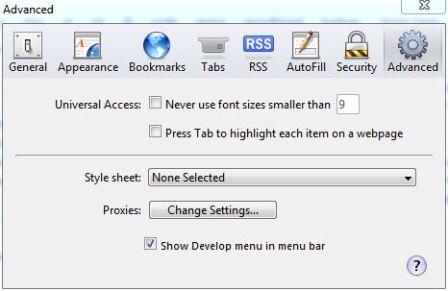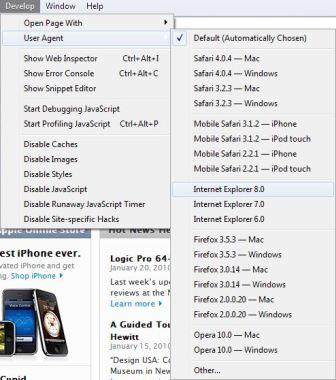Most web browser does not have capability to allow user to change the user-agent string directly without the help of add-on, extension or plug-in, with the notably exception of Apple Safari web browser. User-agent string is transmitted to web server to make known the browser’s application type, operating system, software vendor, or software revision.
Internet users may want to alter or change the user-agent string that been submitted to the remote server for various reasons. For example, some web pages or web apps only support and allow specific type of web browsers, specifically IE and Firefox. Some web services have a pay wall where visitors must pay or subscribe in order to view the content, but by faking and spoofing as search engine spider or crawlers, the content is accessible for free. Besides, some websites serve different contents to different type of devices, making changing of user-agent necessary (such as emulate iPhone in Safari desktop browser) to access content pages targeted to specific browser.
In order to fake and spoof user-agent string in Safari in Windows or Mac OS X, follow these steps:
- In Safari, click on Edit on menu bar, and go to Preferences.
Tip: If menu bar is hidden, press Alt key to reveal and show the menu bar.
- Go to Advanced tab.
- Select and check the checkbox for Show Develop menu in menu bar option.

- Close the Preferences dialog window, and a new “Develop” menu will show in the menu bar.
- Click on Develop on menu bar, and then select User Agent in the pull down menu. A list of commonly used user agents are listed. Select any of them if available, or else click on Other to enter custom defined user agent string to use in Safari.

List of predefined user-agents in Safari include:
Safari 4.0.4 – Windows
Safari 4.0.4 – Mac
Safari 3.2.3 – Windows
Safari 3.2.3 – MacMobile Safari 3.1.2 – iPhone
Mobile Safari 3.1.2 – iPod touch
Mobile Safari 2.2.1 – iPhone
Mobile Safari 2.2.1 – iPod touchInternet Explorer 8.0
Internet Explorer 7.0
Internet Explorer 6.0Mozilla Firefox 3.5.3 – Mac
Mozilla Firefox 3.5.3 – Windows
Mozilla Firefox 3.0.14 – Mac
Mozilla Firefox 3.0.14 – Windows
Mozilla Firefox 2.0.0.20 – Mac
Mozilla Firefox 2.0.0.20 – WindowsOpera 10.0 – Mac
Opera 10.0 – Windows
Recent Posts
- Able2Extract Professional 11 Review – A Powerful PDF Tool
- How to Install Windows 10 & Windows 8.1 with Local Account (Bypass Microsoft Account Sign In)
- How to Upgrade CentOS/Red Hat/Fedora Linux Kernel (cPanel WHM)
- How to Install Popcorn Time Movies & TV Shows Streaming App on iOS (iPhone & iPad) With No Jailbreak
- Stream & Watch Free Torrent Movies & TV Series on iOS with Movie Box (No Jailbreak)
 Tip and Trick
Tip and Trick
- How To Download HBO Shows On iPhone, iPad Through Apple TV App
- Windows 10 Insider Preview Build 19025 (20H1) for PC Official Available for Insiders in Fast Ring – Here’s What’s News, Fixes, and Enhancement Changelog
- Kaspersky Total Security 2020 Free Download With License Serial Key
- Steganos Privacy Suite 19 Free Download With Genuine License Key
- Zemana AntiMalware Premium Free Download For Limited Time